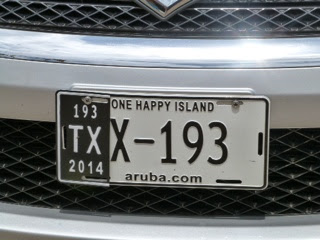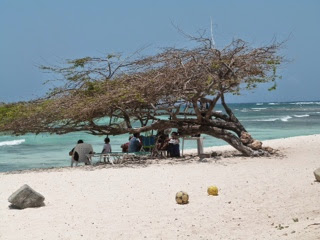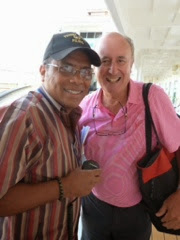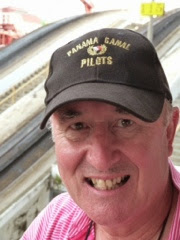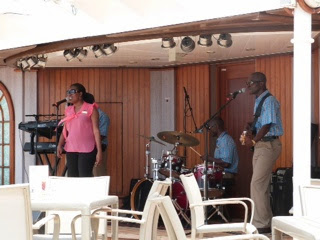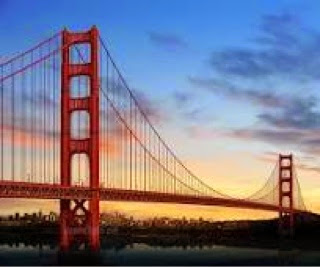“Attorneys at Law” the sign said. I thought It was another jewellery store in the shopping mall but I was wrong. It was a very impressive office, but this is Grand Cayman. Packed with 554 Banks plus Trust Companies, Insurance Companies and all sorts of financial institutions. I decided to leave the lawyers to their own devices.
Aruba
Aruba is about 18 miles north of Venezuela and is now part of the ABC group of islands – Aruba, Bonaire and Curacao. Formerly a part of the Netherlands Antilles, it is now a separate entity within the Kingdom of the Netherlands.
Cloes was the driver. We were told that he was a good driver. He was, when he looked where he was going, but he often turned round to talk to us, and he often took both hands off the wheel to help his explanations!
I climbed them, but the view from the top was not sensational. We then drove to the northern Atlantic coast. An impressive rocky coastline with large waves breaking heavily.
 It was Stop 2. The Natural Bridge. Sadly it collapsed in 2005 as you can see, but a new mini natural bridge is there with the appropriate warning!
It was Stop 2. The Natural Bridge. Sadly it collapsed in 2005 as you can see, but a new mini natural bridge is there with the appropriate warning!


 Stop 3 was the Chapel of Alto Vista. The road to it was blessed with white crosses and extracts from the Lord’s Prayer and other biblical quotes.
Stop 3 was the Chapel of Alto Vista. The road to it was blessed with white crosses and extracts from the Lord’s Prayer and other biblical quotes.


 Also known as the Little Chapel, the pews outside are apparently always packed with worshippers.
Also known as the Little Chapel, the pews outside are apparently always packed with worshippers.
In the sand there are numerous divi divi or Watapana trees whose branches are bent at right angles to the trunk by the ever present trade winds.
The Panama Canal
In 2012 we transited the Canal from the Atlantic to the Pacific in Queen Elizabeth. Today we went in the other direction. We had an amazing, exhausting day.
It was a beautiful morning and Panama City glistened in the distance as the sun rose.
We passed under The Bridge of the Americas at about 0800 and headed for the first series of locks – the Miraflores Locks.
Each locomotive costs between $2 million and $5 million depending on who you speak to! The locomotives do not, usually, pull the ship through, but by means of 2 hawsers and pulleys on each locomotive they keep the ship away from the edge of the canal. The ship is propelled through under its own power.
Decks 5 and 6 forward, usually reserved for the crew, were opened for passengers, and that gave brilliant views of the lock gates and the water levels, but there was no cover and it was hot and humid. My “private” deck on 9 in front of the gym gives a better overall view but Deck 3 astern proved to be the best for Panama.
Amazing
A couple of days ago I pointed out that my late father was born on 6 April 1914 and would have been 100 on Sunday. When I mentioned this at dinner on Sunday evening one of our dinner companions, John Thompson from Sheffield, said that his father was born on the same day in the same year. An amazing coincidence. Three men at the table, two of whom have fathers born on the same day. Could someone please tell me what the odds are of that happening?
Puntarenas, Costa Rica
We arrived in Puntarenas in the middle of the night. Those taking tours were leaving the ship before it was too hot. When I walked out onto the balcony at 0630 the temperature was 84 F and some tours were just leaving.
100 today 6 April 2014
If our late father, Captain George E Smith, who was one of only three men who were Captain of both the old Queen Elizabeth and the QE2, had been alive today, my sister Elizabeth and I would have been celebrating his 100th birthday with him!
San Francisco to Puntarenas
It’s a long way – 2800 nautical miles and we are taking 6 days to get there. The weather has improved dramatically so that the last 3 days have been perfect with temperatures in the mid to high eighties and the only wind being that created by the ship. Today there is no swell at all.
San Francisco
What is going on? There is a water shortage in California. There are financial penalties if you live here and use too much water but from the moment that we sailed under the Golden Gate at 0515 on Monday morning it has rained almost continuously!
His wife Jackie has also recently moved to AdRoll from Twitter. She is their senior director of marketing.
Dan and Jackie live a stones throw from the San Francisco Giants Ball Park.




Back at
Maggies home we were soon in bed exhausted. In the morning we explored Danville after a cooked breakfast and then headed for an Apple store.Roger McGuinn – The Byrds
Founder of The Byrds. Lead guitarist. Lead vocalist. Mr Tambourine Man. Roger McGuinn is the celebrity speaker for this segment and he boarded QV in Honolulu.
He is clearly highly computer literate and that becomes evident, not only in the professional way he presents, but as a result of things others say about him. He has numerous clips of original Byrds performances, recordings and chat show appearances which he deftly plays on the big screen. There are plenty of sound and vision experts employed in the theatre but Roger doesn’t need them.
World Voyage Dinner – Hawaii Convention Centre
This was a first for us. In the past we have sailed on segments of World Voyages, but never the whole thing.
We then moved into a vast hall laid out beautifully with tables for ten.










